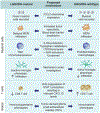The immunology of low-grade gliomas
- PMID: 35104791
- PMCID: PMC9283531
- DOI: 10.3171/2021.11.FOCUS21587
The immunology of low-grade gliomas
Abstract
Low-grade gliomas (LGGs), which harbor an isocitrate dehydrogenase (IDH) mutation, have a better prognosis than their high-grade counterparts; nonetheless, they remain incurable and impart significant negative impacts on patients' quality of life. Although immunotherapies represent a novel avenue of treatment for patients with LGGs, they have not yet been successful. Accurately selecting and evaluating immunotherapies requires a detailed understanding of LGG tumor immunology and the underlying tumor immune phenotype. A growing body of literature suggests that LGGs significantly differ in their immunology from high-grade gliomas, highlighting the importance of investigation into LGG immunology specifically. In this review, the authors aimed to discuss relevant research surrounding the LGG tumor immune microenvironment, including immune cell infiltration, tumor immunogenicity, checkpoint molecule expression, the impact of an IDH mutation, and implications for immunotherapies, while also briefly touching on current immunotherapy trials and future directions for LGG immunology research.
Keywords: immune cell infiltration; immunology; low-grade glioma; microenvironment.
Figures
References
-
- Pouratian N, Asthagiri A, Jagannathan J, Shaffrey ME, Schiff D. Surgery Insight: the role of surgery in the management of low-grade gliomas. Nat Clin Pract Neurol. 2007; 3(11): 628–639. - PubMed
-
- Duffau H, Capelle L. Preferential brain locations of low-grade gliomas. Cancer. 2004; 100(12): 2622–2626. - PubMed


